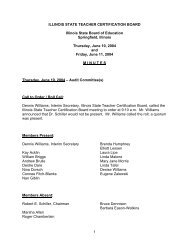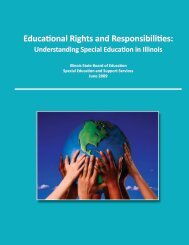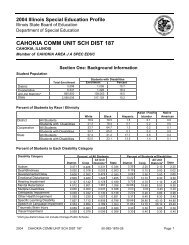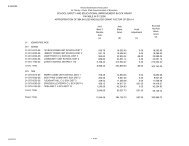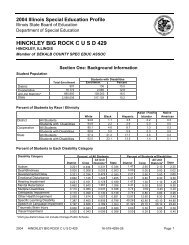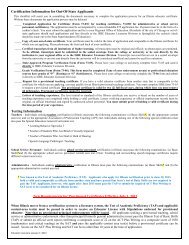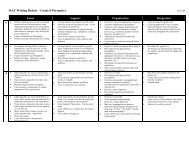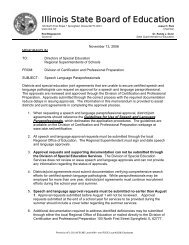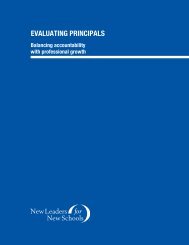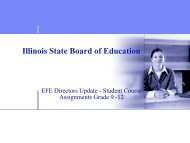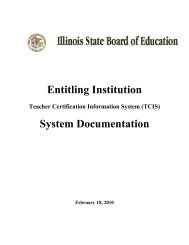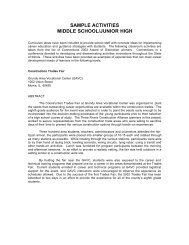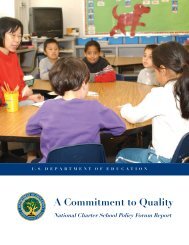Introduction to the Early Childhood Environment Rating Scale ...
Introduction to the Early Childhood Environment Rating Scale ...
Introduction to the Early Childhood Environment Rating Scale ...
You also want an ePaper? Increase the reach of your titles
YUMPU automatically turns print PDFs into web optimized ePapers that Google loves.
<strong>Introduction</strong> <strong>to</strong> <strong>the</strong> <strong>Early</strong><br />
<strong>Childhood</strong> <strong>Environment</strong><br />
<strong>Rating</strong> <strong>Scale</strong> (ECERS)
What is ECERS?<br />
• Baseline scores<br />
• Program improvement<br />
• Professional development<br />
• Technical assistance
What is ECERS?<br />
• Not high stakes test<br />
• Not used <strong>to</strong> compare<br />
programs<br />
• Not used <strong>to</strong> determine funding<br />
• Not a competition
Three Basic Needs<br />
In order <strong>to</strong> provide quality of life, care and<br />
education, we must provide for <strong>the</strong><br />
three basic needs of all children.<br />
• Protecting <strong>the</strong>ir health and safety<br />
• Providing opportunities for stimulation and<br />
learning from experience<br />
• Building relationships with children, parents,<br />
extended family and community<br />
All three of <strong>the</strong>se areas are equally important
Protecting<br />
• Health<br />
– Nutrition<br />
– Sanitation<br />
– Personal hygiene, self<br />
help<br />
– Measures <strong>to</strong> reduce<br />
infectious diseases in<br />
group settings<br />
• Safety<br />
– Precautions <strong>to</strong> avoid<br />
injury from mishaps<br />
(e.g., resilient ground<br />
cover)<br />
– Supervision<br />
– Prevention of abuse<br />
and neglect
Providing Opportunities<br />
• Variety of hands-on activities<br />
• Appropriate for group and individual needs<br />
• Many open-ended materials<br />
• Schedule that handles routines gracefully<br />
and leaves ample time for activities<br />
• Language related <strong>to</strong> activities<br />
• Concepts brought out in play
Building Relationships<br />
• With Children<br />
– Separation from<br />
parents<br />
– Continuity of care;<br />
primary caregiver<br />
– Positive approaches <strong>to</strong><br />
guidance and<br />
discipline<br />
– Development of social<br />
skills<br />
• With Parents<br />
– Opportunities for<br />
communication –<br />
formal and informal<br />
– Building trust over time<br />
– Parent support and<br />
education<br />
– Anti-bias approach,<br />
cultural sensitivity<br />
– Tuned-in <strong>to</strong> child’s<br />
community
Using ECERS<br />
• <strong>Environment</strong> <strong>Rating</strong> <strong>Scale</strong>s may be<br />
used in a variety of ways for different<br />
purposes.<br />
• All of <strong>the</strong>se will be helpful in<br />
improving <strong>the</strong> quality of your program.
Uses of <strong>the</strong> <strong>Scale</strong>s<br />
Self-assessment – providers may use <strong>the</strong>m<br />
<strong>to</strong> assess <strong>the</strong>ir classrooms using <strong>the</strong><br />
correct scale for type of provider and ages<br />
of children.
Uses of <strong>the</strong> <strong>Scale</strong>s<br />
• Technical Assistance – consultants use<br />
<strong>the</strong> scales with programs <strong>to</strong> identify<br />
strengths and areas in need of<br />
improvement.
Uses of <strong>the</strong> <strong>Scale</strong>s<br />
• Quality <strong>Rating</strong> Assessment – conducted<br />
by assessors who have participated in<br />
extensive training and achieved “inter-rater<br />
reliability.”
How Do You Measure Quality?<br />
• Structural Indica<strong>to</strong>rs<br />
– Staff-child ratio<br />
– Group size<br />
– Practitioner education<br />
– Practitioner wages<br />
– Price of Care<br />
These provide <strong>the</strong> basis<br />
for quality, but do not<br />
assure that <strong>the</strong>re is<br />
quality care going on in<br />
<strong>the</strong> program setting.<br />
They are not considered<br />
when you are scoring<br />
<strong>the</strong> ECERS as <strong>the</strong>y are<br />
not a part of <strong>the</strong><br />
environment that<br />
affects <strong>the</strong> child.
How Do You Measure Quality?<br />
• Process quality<br />
assessment<br />
– Interactions among<br />
people (staff-child,<br />
child-child)<br />
– Materials<br />
– Arrangement of space<br />
– Schedule of <strong>the</strong> day<br />
– How children interact<br />
with space and<br />
materials<br />
Process quality<br />
assessment is based<br />
on <strong>the</strong> observation of<br />
<strong>the</strong> ongoing daily<br />
program.<br />
It is a better indica<strong>to</strong>r of<br />
<strong>the</strong> level of future<br />
success for children<br />
in <strong>the</strong> elementary<br />
school grades.
<strong>Environment</strong> <strong>Rating</strong> <strong>Scale</strong>s are:<br />
• Observation-based instruments<br />
• Comprehensive coverage (global)<br />
– Health and safety<br />
– Relationships<br />
– Opportunities for learning<br />
• Reliable and valid
ECERS is A Valid Instrument<br />
• To be considered valid, <strong>the</strong> <strong>to</strong>ol must answer <strong>the</strong><br />
question, “Does it measure what’s important?”<br />
In o<strong>the</strong>r words, we want proof that <strong>the</strong> scale<br />
scores are valid and measuring quality care and<br />
education for children.<br />
• ECERS is validated by research.<br />
• Valid means that if you measure reliably you can<br />
predict an outcome of interest.<br />
– Validity of ECERS measures <strong>the</strong> impact on <strong>the</strong><br />
children (i.e. higher scores equal children with<br />
stronger social skills)
ECERS is A Reliable Instrument<br />
• A ruler is an accurate, reliable<br />
measurement <strong>to</strong>ol. No matter what type of<br />
ruler you use, <strong>the</strong> measurements will<br />
always be <strong>the</strong> same.<br />
• <strong>Scale</strong>s are reliable, but must be used<br />
reliably by trained scorers or assessors.
What is Inter-Rater Reliability?<br />
• Refers <strong>to</strong> <strong>the</strong> consistency of <strong>the</strong> assessors in<br />
scoring <strong>the</strong> items of <strong>the</strong> scales.<br />
• A high level of inter-rater reliability means that if<br />
2 assessors observe <strong>the</strong> same program, <strong>the</strong><br />
likelihood of having <strong>the</strong> same score is high.<br />
• Assessors who have been trained <strong>to</strong> a high level<br />
of inter-rater reliability are able <strong>to</strong> use <strong>the</strong> scales<br />
accurately and consistently, ensuring that no<br />
matter where <strong>the</strong> provider is located and which<br />
assessor is doing <strong>the</strong> observation, <strong>the</strong> results<br />
are consistent.
What do <strong>the</strong> <strong>Scale</strong>s Predict?<br />
• Children in higher quality settings are<br />
found <strong>to</strong> have better school success in <strong>the</strong><br />
following areas:<br />
– Language ability<br />
– Pre-Academic skills (math and reading<br />
readiness)<br />
– Attitudes <strong>to</strong>wards teachers and perceptions of<br />
<strong>the</strong>ir own competence<br />
– Relationships with caregivers<br />
– Social skills
Definitions<br />
• Accessible-children can reach and are<br />
allowed <strong>to</strong> use age appropriate <strong>to</strong>ys,<br />
materials, furnishings and/or equipment.<br />
• Much of <strong>the</strong> Day- If children are<br />
prevented from using materials for long<br />
periods by lengthy routines, being kept in<br />
groups, or being kept in areas where<br />
access is not possible, credit cannot be<br />
given for “much of <strong>the</strong> day.”
Definitions<br />
• Substantial Portion of <strong>the</strong> Day – 50 minutes in<br />
half day program<br />
• Some and many are used throughout <strong>the</strong><br />
scales <strong>to</strong> denote frequency, especially in items<br />
that evaluate language and interactions.<br />
Specific guidelines are included in <strong>the</strong> notes for<br />
clarification.<br />
• Wea<strong>the</strong>r Permitting – Almost every day unless<br />
<strong>the</strong>re is active precipitation (temperature<br />
between 25 and 90 degrees, taking in<strong>to</strong><br />
consideration wind chill)
Hand Washing<br />
• Everyone needs <strong>to</strong> wash <strong>the</strong>ir hands with<br />
running water.<br />
• Wet hands first and <strong>the</strong>n add soap.<br />
• Rub hands <strong>to</strong>ge<strong>the</strong>r for 15 seconds.<br />
• Hands must be dried by individual <strong>to</strong>wels<br />
that are not shared or hand dryers.
Hand Washing<br />
• Using wipes or<br />
antiseptic waterless<br />
washes CANNOT be<br />
substituted for hand<br />
washing.<br />
• Glove use does not<br />
preclude hand<br />
washing.
Alignments<br />
IELS<br />
ECERS<br />
Language Arts<br />
Ma<strong>the</strong>matics<br />
Science<br />
Social Science<br />
Physical Development and Health<br />
Fine Arts<br />
Social and Emotional Development<br />
Language and Reasoning<br />
Math and Number<br />
Nature and Science<br />
Interactions among children<br />
Promoting acceptance of<br />
diversity<br />
Space and furnishings<br />
Activities<br />
Interaction
Why Use <strong>the</strong> <strong>Environment</strong> <strong>Rating</strong><br />
<strong>Scale</strong>s?<br />
Because children<br />
deserve <strong>to</strong> be in<br />
quality environments<br />
and parents need <strong>the</strong><br />
assurance of knowing<br />
<strong>the</strong>ir children are<br />
safe, healthy and<br />
learning.



